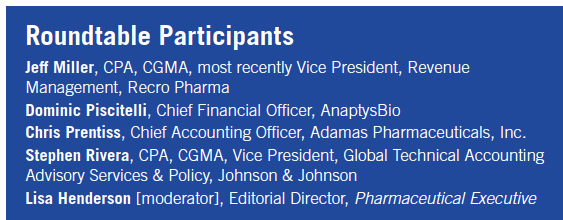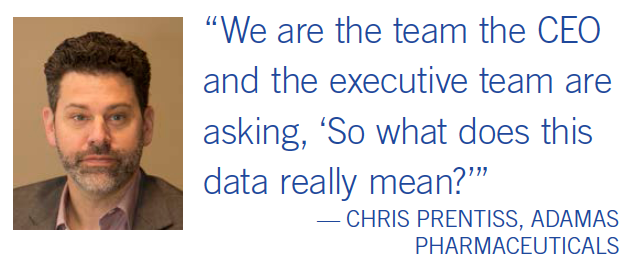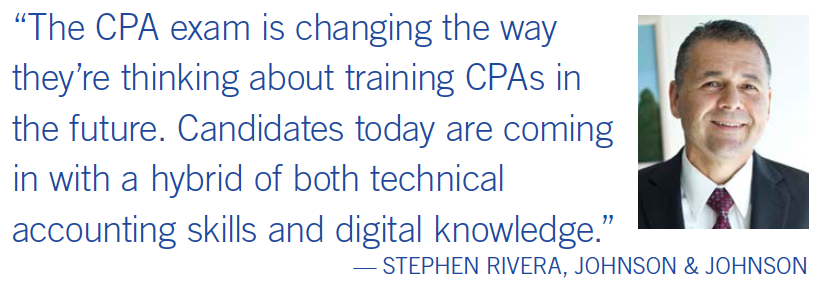Dollars and Digital: The Future of Pharma Finance
Pharmaceutical Executive
In this executive roundtable, pharma and biotech finance leaders discuss the pace of digital technology adoption in accounting and reporting, and the growing recognition of data and analytics-over traditional numbers crunching-in delivering deeper business insights across the organization.
Pharm Exec convenes a panel of biopharma finance leaders to discuss the pace of digital technology adoption in accounting and reporting-and the growing role and responsibility of finance teams in harnessing data and analytics to deliver deeper and more strategic insights across the organization
At the most recent CBI Annual Life Sciences Accounting & Reporting Congress, held in March in Philadelphia, a select group of senior-level biotechnology and pharmaceutical financial executives gathered to discuss “The Evolution of Finance in the Digital Revolution.” From the technology adoption in their own organizations, to how technology impacts the future financial department employee, to examining the ROI of an increasingly digital world, the following is an edited transcript of the discussion.

Photo/Tom Grimes. (Left to right) Dominic Piscitelli, of AnaptysBio; Stephen Rivera, of Johnson & Johnson; Jeff Miller, formerly of Recro Pharma; and Chris Prentiss, of Adamas Pharmaceuticals.

PE: Where would you place your company on the digital technology adoption curve?
CHRIS PRENTISS, Adamas Pharmaceuticals: Adamas Pharmaceuticals is a relatively small biotech. We launched our first drug a little over a year ago, which we distribute through a specialty pharmacy. Therefore, we have access to a lot of data-and it’s very rich information. But what do we do with it and how do we transform that data into insights? From a company perspective, it is a huge focus for us. A finance department is used to dealing with a lot of data, but now we are really being brought into the discussion of how we translate it into insights. I think this is a great opportunity for the finance department to be more involved in the business. And the need is there to learn the business at a much deeper level because we are the team the CEO and the executive team are asking, “So what does this data really mean?”

Even though we are a small biotech and may not have the tools and resources that other organizations have, our CEO/founder has a computer science PhD, so he recognizes the value of data and analytics. But if you compare us to other pharmaceutical companies, I imagine we are pretty low on the maturity curve.
STEPHEN RIVERA, Johnson & Johnson: Looking at accounting and reporting technology adoption, I would say we may be at the beginning. J&J’s history is all based on a very decentralized portfolio of companies, but since I’ve been here, the consolidation of accounting and reporting and bringing it all together under one system has been a behemoth undertaking.
We have three huge businesses-pharmaceutical, device, and consumer-which all have different needs, but they all have to talk to each other and work together. How do you come up with the highest and best digital solution to support them as well as give the insights you need to run your company, the broad brush of a healthcare company like Johnson & Johnson?
I think we’re still in the beginning parts of coming up with a solution that would give us what we’re looking for down the road.
JEFF MILLER, most recently Recro Pharma: I got into pharma 12 years ago at a relatively small company. And what I’ve experienced is, it seems like our digital needs and journey kind of paralleled the growth of the company.
Our journey started about eight years ago with an upgrade to a big-time ERP (enterprise resource planning) system. I feel like that’s usually the springboard for a company’s digital growth. After that, we addressed our top priorities, which were trying to manage the financial close process better, managing big data, and managing gross-to-net for a growing drug portfolio. Like Stephen and Chris, we’re dealing with a lot of transactional data from multiple source systems. And you have users in the Finance and Sales departments who don’t realize that they’re using variations of the same data in their different presentations to management. This can often create confusion.
Our gross-to-net and price-change management processes were automated with a third-party solution provider because, at the time, we were an all-generics company dealing with customer pricing and discounting terms that were changing daily with high volume.
The company implemented Cognos as its central data repository for all internal and external data sources in order to create “one-version-of-the-truth” reporting across all functional areas of the company.
All that digital growth transpired over a period of about five years, which left us in a good spot in terms of accomplishing our goals. But I have to say, you can never completely remove yourself from Excel. Even though we’ve automated the complex gross-to-net calculations, we still need Excel. In many cases, data is extracted from an automated solution so it can be further manipulated in Excel.
DOMINIC PISCITELLI, AnaptysBio: I’m very supportive of the adoption and implementation of digital technology to the appropriate level and at the appropriate time. AnaptysBio is a clinical stage development company focused on inflammation; we have approximately 80 to 90 employees, and we have been a public company for a little over two years. We don’t have any complex collaborations and we don’t have any commercial products. For the year ended 2018, we were required to be SOX 404(b) compliant, which adds a new level of complexity and disclosure. We currently operate with a basic ERP system and we still do certain activities manually.
When you’re an R&D company, you’re burning cash and you need to be thoughtful and spend where there’s a higher ROI, where investors want to spend their money, which is R&D.
But now as our pipeline has advanced to Phase II and we are well-capitalized, it is something we’re starting to spend more time assessing and evaluating and developing a three-year IT plan. I believe now is the time to start evaluating and making initial investments in more advanced technology. In my opinion, this is the typical life cycle for investing in the technology for earlier stage biotechs. You’re just not going to implement a system, an Oracle or an SAP, with those significant implementation and maintenance costs. It just doesn’t make sense at an earlier stage.
RIVERA: I agree.
PISCITELLI: Some of the advances I’ve heard here at the conference with larger organizations, such as using robotics or bots to help them with their balance sheet analytics and income statement analytics, are great. But it’s not practical for a company like us today.
I think it’s just a natural progression. I’ve been in situations in the past, such as having a commercial product or a partnership with a large pharma, and a collaboration and cost-sharing relationship where you need real-time accurate information transmitted back and forth between the company and your partners on sales and expenses. In those cases, I can see where some sort of blockchain technology can makes sense. But that’s many years away from where we are today.
PE: In regard to employees and current practices and technologies, where are the current skill sets and where is the future of your workforce?
PRENTISS: From a small pharma perspective, the skill set of the finance department certainly has to evolve and change. It’s a lot more than, “do you know how to use Excel, or do you have any ERP experience?” The data is so much more immense that you need to have some experience with additional analytic tools. For example, using Alteryx to be able to crunch data in a way that the finance department hasn’t had to worry about in the past.
But, again, how do you get value out of that data? You can’t just run to IT or commercial ops every day to do that. That skill set is becoming more and more a requirement of what you’re doing. Our auditors are even learning how to use these tools. You’re looking for a different type of person than maybe somebody who’s just turning the crank and handing a report to the business; business is looking for a lot more from finance departments these days.
MILLER: I’ve seen a shift in the last five years as the Finance department grew. We were always looking for people with the basic accounting skills, accounting degrees, and hopefully CPA licenses. But we now have to put a lot more weight in the profile for candidates on their data manipulation skills and data integrity.
I feel if they walk in the door without strong data skills, you are at a disadvantage. Once we started hiring employees with these data skills, it allowed us to be more strategic and create business analyst roles that service several areas within the finance organization. An analyst could be the designated super-user, say in Cognos, and can then fulfill the data reporting needs of the whole team.
RIVERA: The CPA exam is actually changing the way they’re thinking about training CPAs in the future. Candidates today are coming in with SAP (system applications and products) knowledge, with basic data understanding and technical accounting as well-a kind of a hybrid of both technical skills and digital knowledge.

I also think a younger generation is coming in and they want to work for an employer that’s up to speed on what’s new in digital. They get very frustrated when they come into a company and all they have is Excel. We have a lot of recruiting here at Johnson & Johnson and we want to keep everything fresh and current. But we hear that the younger generation is used to having the latest technology and that’s what they’re expecting employers to have.
MILLER: With the younger generation, they don’t want to be put in a box. They want to keep moving, and they want to continually expand their skill sets. If they see an interest from Finance leadership that we care about their professional goals, that’s huge for job retention.
For instance, if you have someone who is getting their master’s degree in data integrity and you put them in charge of your central data repository and empower them to fulfill the needs of the whole Finance department, all of a sudden you should have an invested employee for the next few years.
PISCITELLI: I agree with all of the points discussed. The other side of the coin is investing in your current staff. I think you have the dynamics of attracting the right people, but you also have the dynamics of motivating your current staff to start thinking outside the box and encouraging them to evaluate and adopt new technology and look for opportunities to streamline processes and for automation. It’s human nature to be hesitant or resistant to change and encouraging employees to adopt new technologies or processes can sometimes be challenging.
PE: Does the decision to implement technology come from the top down?
MILLER: In certain situations, I think the executive team has to have an appetite for investing to mitigate financial risk. For example, at the time we invested in gross-to-net automation, we knew that we were going to be beta. There was no generic company in industry that had a full-suite gross-to-net automation solution. The benefit was it probably kept our costs down because it was just as much of an investment for the vendor

that we used. And we knew there would be pain. But when you are dealing with a large amount of dollars in accounting true-ups, that’s what kick-started the process of investing in technology.
But sometimes it comes down to the individual. I pitched something to our Finance leadership eight years ago, and there was no appetite for it at that time. Two years later, my audience was a new CFO and VP of Finance, who basically said: “I don’t see why you haven’t done this already.” So it’s all about appetite and willingness to be at the forefront of technological growth.
PRENTISS: And comfort. Are you set in your ways? Are you ready to move with the times? That’s a big part of it. And you also want to think about technology from a retention perspective. How do you continue to transition your employees work to value-level work and get through the close as quickly as possible and get on to the projects and the fun stuff?
RIVERA: I was in a presentation with one of the accounting firms. By having one system, they can go in and have the robot do all the auditing, and they can test journal entries. They could say, “Who did all the testing of the journal entries?” And they can find the one journal entry that one person does once a month. I was an auditor once. I said, wow. Even if I sampled a hundred, how would you find the one person that does it once a month? It is just an example of how a robot could find things that we as humans could never pore through that big data to come up with.
PISCITELLI:I think bots can be implemented to replace the basic routine transactions. They can be used for certain transactions like testing of issues such as separation of duties (e.g., posting and approving journal

entries), and I would expect auditing firms will adopt some of these processes. In the future, mid-sized biotechs may consider implementing as well.
But I don’t think it ever replaces the human element of analyzing things and providing that value-add.
Lisa Henderson is Pharm Exec’s Editor-in-Chief. She can be reached at lhenderson@mmhgroup.com

Reshema Kemps-Polanco: Taking Risks for Greater Reward
May 14th 2025Reshema Kemps-Polanco, executive VP and chief commercial officer, Novartis US, and the 2025 Healthcare Businesswomen’s Association Woman of the Year, uses the lessons she learned from her family to bring out the best in her teams.